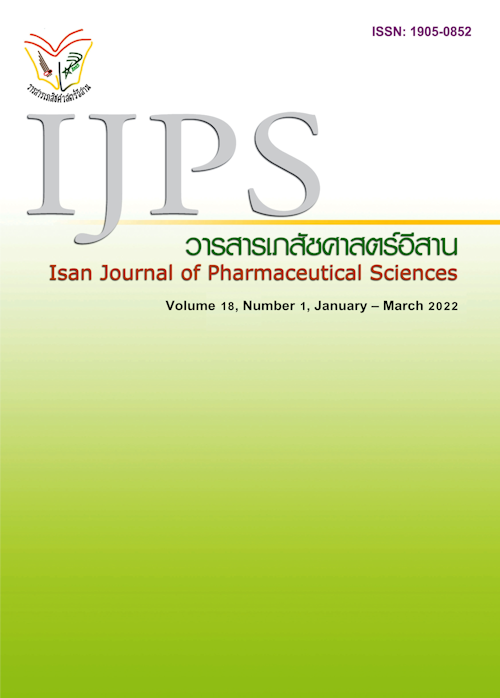Plasma Ammonia Level In Patients Receiving Valproic Acid At Srinagarind Hospital: A Case Series
Main Article Content
Abstract
Introduction: Valproic acid, a widely used antiepileptic drug and antipsychotic drug, has a high efficacy. However, its side effects can occur in many organs, especially in the central nervous system and valproate-induced hyperammonemic encephalopathy (VHE) has been reported. This study aimed to examine plasma ammonia level and any information which might associate with factors affecting plasma ammonia level in patients with valproic acid therapy. Methods: A retrospective descriptive study was conducted in patients who received valproic acid therapy and had at least one plasma ammonia level in Srinagarind Hospital between 1st January and 31st December 2020. Patient demographic data, drug profile, underlying diseases, and side effects were collected. Results: The mean age of 13 patients (8 females, 5 males) was 40.08±28.45 years old with an average BMI 19.50±3.81 kg/m2. Hyperammonemia was defined by using a cut point of plasma ammonia level higher than 50 μmol/L. The average plasma ammonia level was 81.87±56.05 μmol/L (33.6-222.3 μmol/L). Nine (69.24%) patients had hyperammonemia (6 females, 3 males). Total valproic acid level was reported in 6 (46.15%) patients with an average level of 94.08 mg/L. Free valproic acid level was reported in 2 (15.38%) patients (15.97 and 38.79 mg/L) and both were above the therapeutic range. The median valproic acid dose in patients was 1000 mg/day (120-2400 mg/day) or 20.78 mg/kg/day (4.41-44.44 mg/kg/day). The total valproic acid dose was above 20 mg/kg/day in most of the hyperammonemic patients. Conclusion: This study revealed that the information which might associate with factors affecting plasma ammonia level in patients were the total daily dose of valproic acid and combination treatment with antiepileptic drugs and antipsychotic drugs. Monitoring plasma ammonia level may be useful for active surveillance in valproic acid safety in the patients at risk.
Article Details

This work is licensed under a Creative Commons Attribution-NonCommercial-NoDerivatives 4.0 International License.
In the case that some parts are used by others The author must Confirm that obtaining permission to use some of the original authors. And must attach evidence That the permission has been included
References
Carr RB, Shrewsbury K. Hyperammonemia due to valproic acid in the psychiatric setting. Am J Psychiatry. 2007;164(7):1020–7.
Chopra A, Kolla BP, Mansukhani MP, et al. Valproate-induced hyperammonemic encephalopathy: An update on risk factors, clinical correlates and management. Gen Hosp Psychiatry. 2012;34(3):290–8.
Dealberto MJCC. Valproate-induced hyperammonaemic encephalopathy: Review of 14 cases in the psychiatric setting. Int Clin Psychopharmacol. 2007;22(6):330–7.
Guo X, Wei J, Gao L, et al. Hyperammonemic coma after craniotomy: Hepatic encephalopathy from upper gastrointestinal hemorrhage or valproate side effect? Med (United States). 2017;96(15):1-6.
Lewis C, Deshpande A, Tesar GE, et al. Valproate-induced hyperammonemic encephalopathy: A brief review. Curr Med Res Opin. 2012;28(6):1039–42.
Lind J, Nordlund P. Intravenous use of valproic acid in status epilepticus is associated with high risk of hyperammonemia. Seizure. 2019;69(October 2018):20–4.
Mock CM, Schwetschenau KH. Levocarnitine for valproic-acid-induced hyperammonemic encephalopathy. Am J Heal Pharm. 2012;69(1):35–9.
Noh Y, Kim DW, Chu K, et al. Topiramate increases the risk of valproic acid-induced encephalopathy. Epilepsia. 2013;54(1):e1-e4.
Segura-Bruna N, Rodriguez-Campello A, Puente V, et al. Valproate-induced hyperammonemic encephalopathy. Acta Neurol Scand. 2006;114(1):1–7.
Tseng YL, Huang CR, Lin CH, et al. Risk factors of hyperammonemia in patients with epilepsy under valproic acid therapy. Med (United States). 2014;93(11):e66.
Wadzinski J, Franks R, Roane D, et al. Valproate-associated hyperammonemic encephalopathy. J Am Board Fam Med. 2007;20(5):499–502.
Woo PYM, Woo AWY, Lam SW, et al. Incidence, Presentation, and Risk Factors for Sodium Valproate–Associated Hyperammonemia in Neurosurgical Patients: A Prospective, Observational Study. World Neurosurg. 2020;144:e597–604.
Yamamoto Y, Takahashi Y, Suzuki E, et al. Risk factors for hyperammonemia associated with valproic acid therapy in adult epilepsy patients. Epilepsy Res.


